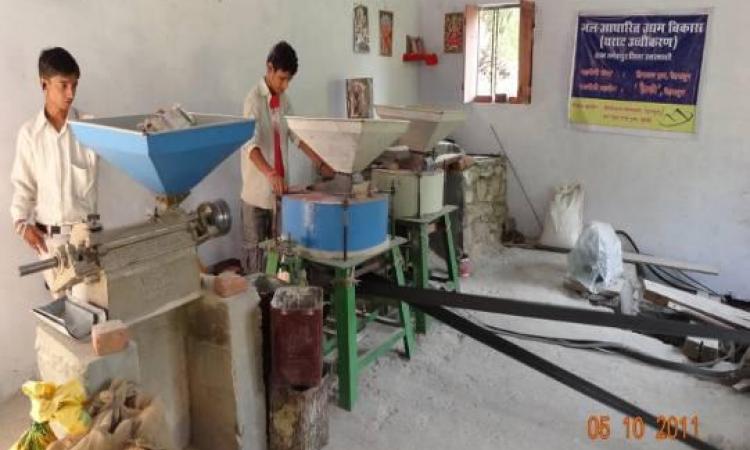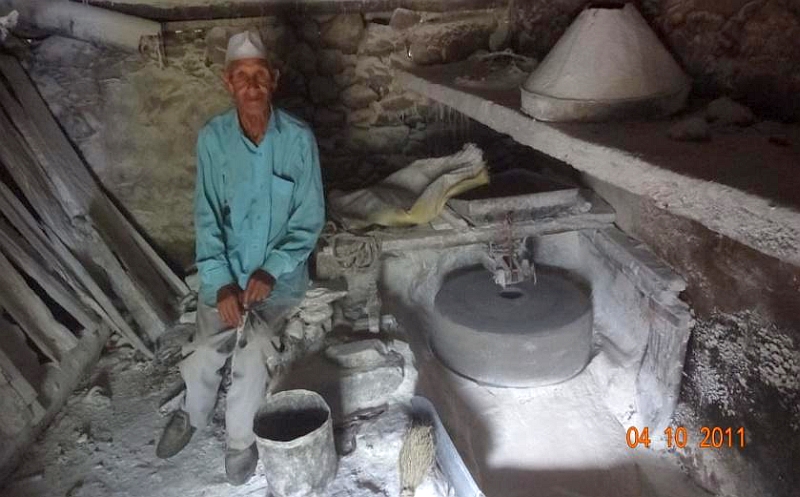
Gharats are water-powered grinding mills found in Himalayan villages. Though these are owned and managed by individuals, they are considered to be the common property of the entire village. Traditionally, the villagers contributed labour to the gharat owner at the time of its installation or during repairs in return for which their grains were ground for free for social and religious ceremonies.
Each gharat is generally set up along the bank of a perennial stream close to the village. The water of the stream is diverted through a channel up to the site of the mill-house, which is generally constructed at a point where a waterfall of 2 to 6 meters is achieved from the channel. A long wooden chute consisting of an open channel made either of wooden planks or carved from a large tree trunk is narrowed down towards the lower end forming a nozzle. The force of the water let through the chute strikes the blades of the turbine in the mill-house and rotates the wheel, which in turn rotates the wooden shaft. The average power output of a gharat ranges from 1.0 KW to 1.5 KW and the grinding capacity ranges from 4-8 kg flour per hour depending on water availability and types of grains.
Himmotthan Society, an organisation working on water and livelihood issues in Uttarakhand, and Himalaya Trust, an organisation working on livelihoods in Uttarkashi, initiated a pilot project focusing on two gharat units at Ganeshpur and Bon villages in Uttarkashi district. The pilot was designed to improve the efficiency of these units, develop better models and explore ways of improving their viability.
All gharat owners of Ganeshpur and Bon village belong to the category of marginal farmers, with average land holdings of 1 to 2 acres. The income of traditional gharat owners varies from Rs. 2,000 to Rs. 2,800 per month. Each gharat is in operation for only 15-18 days a month and grinds about 1900 kg of wheat during that period. Declining agriculture output in the area is the reason for the lull in grinding through the rest of the month. Considering the annual aggregate income from milling, agriculture and livestock farming, the per capita income of a gharat owner’s family varies from Rs. 66-93 per day.
Currently, only 25% of families in Ganeshpur and Bon use gharats. Most of them either buy wheat flour directly from the market or use diesel mills located near the market for grinding. A number of factors are responsible for the decrease in the quantity and efficiency of gharats. These include:
- Increase in migration of people from villages
- Prevalence of occupations other than agriculture (business, service, contractor etc)
- Better road network and availability of diesel mills at local market places
- Decreased availability of skilled labour for setting up new gharats and repairing old ones
- Decrease in community spirit for sharing of labour in the installation/repairing of gharats
- Lack of required quantity of timber to set up the gharat
- Decrease in spring water flow
- Lack of access to improvement/modifications in the traditional gharat technology
- Decrease in productivity of subsistence crops
- Increased dependence on market for ration and supplies

Functioning of improved gharats
The wooden parts of the traditional gharats were replaced with metal ones (including ball bearings). This increased its efficiency by 40% to 50%. Similarly, those gharats where adequate flow of water and head - the height from which water approaches the turbines - were available to produce at least 5.0 KW of power at the shaft were modified to generate electricity. The generated electricity was used for lighting and to run other machines directly for grinding, threshing, oil extraction, etc.
The operation and maintenance procedures of the improved gharats are simple and can be carried out with locally available resources and expertise. Vinayak Water Based Enterprise Development Federation in Ganeshpur is responsible for all operation and maintenance (O&M) as well as collecting monthly changes from the families for O&M. It also ensures that all assets are insured.
Limitations to the wider use of improved gharats and limitations to continued upgrading
- Although the grinding efficiency of the upgraded gharats increased up to four to five times, there is no substantial increase in the quantity of food grains availability for grinding because of constant decrease in the land area under cultivation and productivity of subsistence crops. Hence, there is a very little increase in the income of the improved gharat owners from grinding. Therefore in addition to upgradation of gharats, it is equally important to strengthen forward and backward linkages of gharats.
- Gharats are owned by individuals; therefore, upgrading and maintaining it is entirely dependent on the gharat owner’s initiative. Moreover, the economic benefit of improved gharats mostly goes to the individual family rather than to the community. Traditionally, the gharat owner used to collect grinding charges in kind, which was very convenient for poor families. In return, these families used to contribute free labour to the gharat owner during repair and maintenance. However, after these improvements were made, the gharat owners started collecting grinding charges in cash, which is almost equal in rate to the diesel mills. This takes away the benefit of grinding at the gharat and also weakens the age-old social inter-linking of villagers associated with the gharats.
- Gharats are generally situated at a distance of 1-3 km from the village in isolated places, especially along the banks of rivers/streams. These areas are highly inaccessible due to lack of availability of road/transportation facilities.
- The energy generated from the improved gharats is best used when the larger part is consumed on the spot as mechanical energy, without the intervention of electricity generation and transmission. This is applicable to decentralized agro-processing, sawing, and water lifting among others. However, gharats are generally situated far from the village. In this situation, it is uneconomical to take the energy up-to the village because of transmission losses and high unit costs.
This article is an abridged version of a paper that was submitted by the authors for the Sustainable Mountain Summit (Kohima September 25 - 27, 2013). The full paper is attached below.